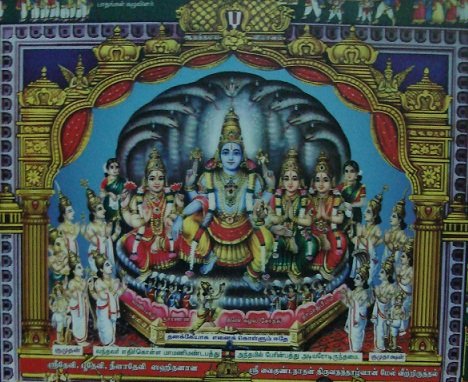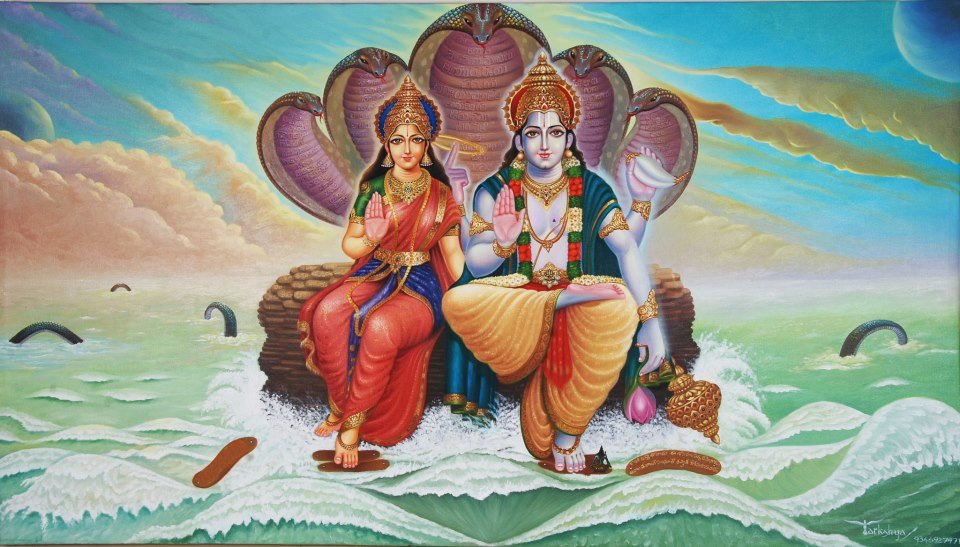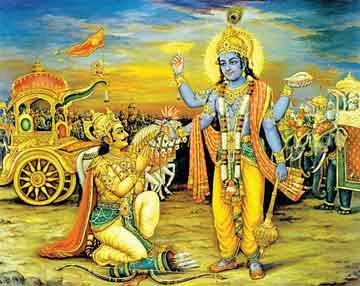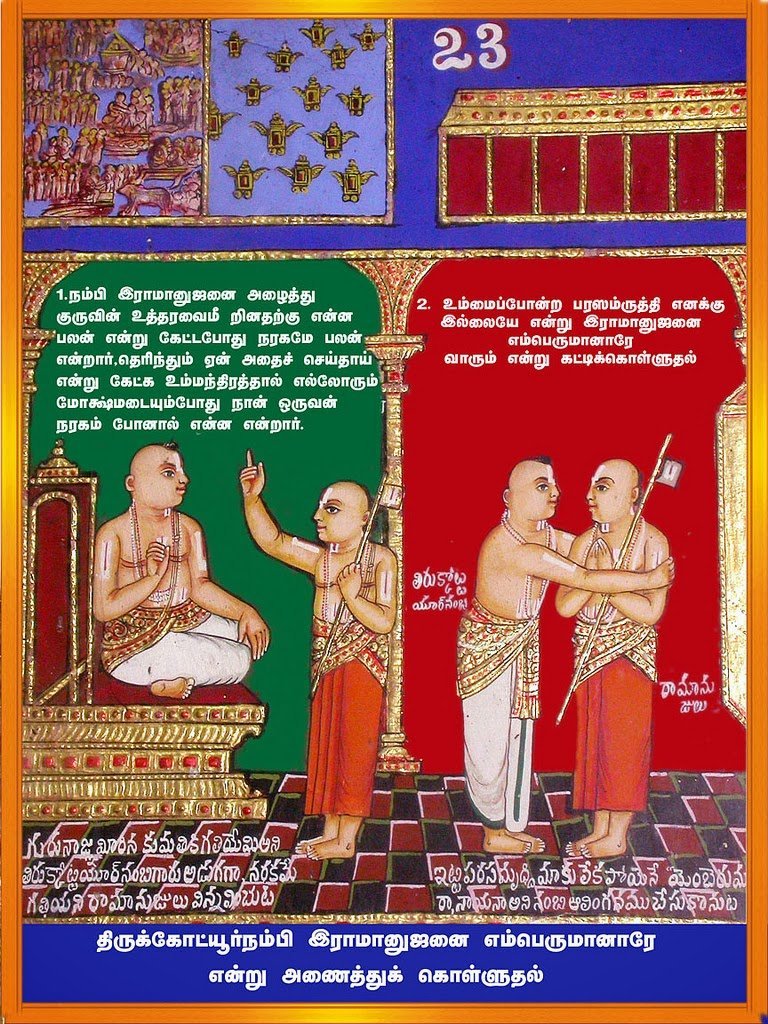
mainly compiled 18 rahasya granthams (confidential matters). Of these
18 granthams, mumukshuppadi, thathva thrayam and srIvachana bhUshaNam
are considered as kAlakshEpa granthams. kAlakshEpa grantham is that
which is to be studied under an AchArya in a word-by-word manner with
the help of the commentaries and further explanations.
- mumukshuppadi is the most precise documentation of the three rahasyams namely thirumanthram (Om namO nArAyaNAya), dhvayam (srIman nArAyaNa charaNau sharaNam prapadhyE; srImathE nArAyaNAya nama:) and charama slOkam (sarvadharmAn parithyajya mAmEka sharaNam vraja; aham thvA sarvapAbEpyO mOkshayishyAmi mA sucha:).
- thathva
thrayam is also known as kutti bhAshyam (meaning a miniature
srIbhAshyam) as it contains the essence of the principles that is
explained in emperumAnAr‘s
srI bhAshyam (which is a commentary for vEdha vyAsa’s brahma sUthram).
This discusses the three fundamental principles namely chith (jIvAthmAs), achith (matter) and Isvaran. A brief summary of this grantham can be viewed at https://granthams.koyil.org/thathva-thrayam-english/.
- srIvachana bhUshaNam is the most comprehensive grantham discussing the various important aspects of srIvaishNavam such as pirAtti‘s purushakArathvam (pirAtti‘s merciful nature in helping jIvAthmAs approach emperumAn), bhagavAn‘s
upAyathvam (bhagavAn being the means to achieve him), srIvaishNava
lakshaNam, glories of srIvaishNavas and finally AchArya abhimAnam (mercy
of AchArya).
General introduction for mumukshuppadi

seated in srIvaikuNtam (which has endless pleasures), being enjoyed by
nithyas (eternally free souls) and mukthas (ones who were relieved from
samsAram) and who is enjoying endless pleasures. Even being in such
blissful situation, he looks at the samsAris (bound souls) in samsAram
(material world) who too are eligible to live in paramapadham and enjoy
endless pleasures, yet they are living in the material world like asath
(the ones who do not understand brahmam are merely considered as matter
which has no intelligence at all) without any knowledge about that
opportunity. Feeling greatly anguished, when these jIvAthmAs
exist without any senses and body during layam (dissolution) just like a
bird without any wings (who wont be able to do anything), he begins his
merciful efforts to facilitate their upliftment.
- First, he blesses the jIvAthmAs with senses and bodies. Without the senses and body, a jIvAthmA cannot function at all. The first action of bhagavAn is to thus provide them with the senses and body.
- Then to facilitate proper use of the senses and body, bhagavAn
presents provides vEdham and its detailed explanations via smruthi,
ithihAsam, purANam, etc. By studying sAsthram and following the
principles that are outlined in sAsthram, one can reach bhagavAn in
paramapadham. vEdham has essentially certain important/unique qualities.
They are:
-
- apaurushEyam – It is not authored by any individual. Even bhagavAn is not the author of vEdham (as it is eternal) – bhagavAn
is the perfect knower of vEdham and reveals it during every srushti
(creation). srushti (creation), sthithi (sustenance) and layam
(dissolution) also happen cyclically (since eternity). - nithyam – it is eternal and always exist. As it is apaurushEyam (not created by any one), it always exists.
- apaurushEyam – It is not authored by any individual. Even bhagavAn is not the author of vEdham (as it is eternal) – bhagavAn
-
- nirdhOsham – blemishless – everything mentioned in vEdham is perfect as it is apaurushEyam. dhOsham
arises due to something being created by individuals who have bramam
(error), vipralambham (deceit – intention to cheat), pramAdham
(negligence), ashakthi (inability). (Note: While certain
aspects may apply for certain types of persons based on their own nature
(sathvam – goodness, rajas – passion, thamas – ignorance), there is
nothing faulty in vEdham).
- nirdhOsham – blemishless – everything mentioned in vEdham is perfect as it is apaurushEyam. dhOsham
-
- svatha:
pramANam – its self-evident – no need to establish vEdham using some
other pramANam – whatever mentioned in vEdham is valid on its own.
- svatha:
- Seeing that
there are many rules and regulations to study and follow sAsthram to
develop ones own knowledge to be uplifted ultimately is very difficult, bhagavAn himself
mercifully becomes an AchAryan (the first AchArya) and reveals the
essence of all sAsthram in the most crisp manner. Thus, he himself
reveals the most important rahasyams (confidential matters) which
explain the following principles:
-
- upAyam – the means to reach bhagavAn
-
- purushArttham – ultimate goal of kainkaryam
these rahasyams, he reveals thirumanthram at srI bhadhrikAshram as
nArAyaNa rishi to nara rishi (who is also an amsam/incarnation) of bhagavAn.

He reveals dhvayam at srI vishNulOkam to his dear consort srI mahAlakshmi.

He reveals charama slOkam at the battle field kurukshEthram near the chariot as krishNan to arjunan.

It is because of bhagavAn
taking up this role of AchAryan, we remember him in the beginning of
our guru paramparai as the prathamAchAryan (first AchAryan) as said in “lakshmInAtha samArambhAm” (beginning with the master of srI mahAlakshmi) thanian by kUrathAzhwAn.
Though these
rahasyathrayam (3 confidential aspects) are short in size, they have
very deep meanings. The meanings of the same must be properly heard from
proper lineage of AchAryas/learned scholars and only by such proper
learning one can be uplifted. This is why our pUrvAchAryas taught and documented the rahasya thrayam with great focus. Coming in the lineage of such great spiritual preceptors, piLLai lOkAchAryar out of his great compassion, documents those essential principles in this grantham (mumukshuppadi).

Even
before writing this, he himself has explained rahasya thrayam in three
different granthams named yAdhruchchikappadi, sriya:pathippadi and
parantha padi. yAdhruchchikkappadi was too short and parantha padi was
too detailed. sriya:pathippadi though did not have both the limitations
(too short and too long), it was filled with samskritham (vEdham)
words/terminologies which are not accessible for women and others.
Wanting to write a grantham which has none of these limitations, piLLai lOkAchAryar mercifully compiled this grantham named mumukshuppadi.
This is why,
amongst all the prabhandhams (granthams), this mumukshuppadi is the
prime focus of everyone. Further, some of the principles that were not
explained in the previous prabhandhams are also present in this grantham
– so this is glorified by all.
Introduction for dhvaya prakaraNam (the section explaining dhvaya mahA manthram)
After explaining the first rahasyam that is thirumanthram, piLLai lOkAchAryar
mercifully explains the principles dhvaya mahAmanthram which reveals
the nature of upAyam (means) and upEyam (goal) that are explained in the
second padham (nama:) and third padham (nArAyaNAya) of thirumanthram
respectively.
piLLai lOkAchAryar
himself in his previous 3 prabhandhams, explained thirumanthra, charama
slOkam and dhvayam. But in this prabhandham, he is explaining dhvayam
before charama slOkam – why so? Both sequence are shown by pUrvAchAryas. Both periyavAchAn piLLai in his parantha rahasyam and vAdhi kEsari azhagiya maNavALa jIyar in his rahasya thraya granthams have followed this sequence (thirumanthram, dhvayam and charama slOkam).
What is the principle behind the two different sequences? There are two explanations:
- The three
rahasymas are explained as manthra, vidhi and anushtAna rahasyams.
thirumanthram is manthram (that which is used to meditate to realize ones true nature), charama slOkam is vidhi (order/instruction – since bhagavAn orders what to give up and what to pursue) and dhvaya mahA manthram is for anushtAnam (constant practice). - thirumanthram is split into two – praNavam (OmkAram) and namO nArAyaNAya (which
is called manthra sEsham (remainder)). The nama: padham which explains
upAyam (means) and nArAyaNAya padham which explains upEyam (goal) are
explained in the two sentences in dhvayam. Further, the two sentences in
dhvaya mahA manthram are explained by the two parts of charama slOkam.
explained in one sequence (thirumanthram, charama slOkam, dhvayam) in
the first 3 prabhandhams, with his desire to explain the other sequence
(thirumanthram, dhvayam, charama slOkam), he is now beginning to explain
the essential meanings of dhvayam.
Introduction for charama slOka prakaraNam (the section explaining charama slOkam)
After explaining dhvayam, the madhyama (middle) rahasyam, piLLai lOkAchAryar starts explaining charama slOkam which is
- the ultimate confidential knowledge
- is the most important aspect of gIthOpanishadh which is the essence/crux of mahAbhAratham which is hailed as panchama vEdham
- expansion of dhvaya mahAmanthram
-
- The first sentence of dhvayam focusses on accepting the lotus feet of srIman nArAyaNan as the means for upliftment. This acceptance is ordered by bhagavAn himself in the first part of charama slOkam. In the same first part, he also explains two other important principles:
-
-
- association with any other upAyam (karma, gyAna, bhakthi yOgams, etc) must be firmly given up
-
-
- The second sentence of dhvayam focusses on doing self-less kainkaryam purely for the joy of srIman nArAyaNan. To be engaged in eternal kainkaryam, one must first be relieved from samsAram and bhagavAn himself guarantees that all hurdles in his path towards such eternal kainkaryam will be removed of him.
To understand the meanings of this charama slOkam only, emperumAnAr walked to thirukkOshtiyUr nambi‘s residence at thirukkOshtiyUr from srIrangam 18 times.
thirukkOshtiyUr nambi
was more concerned about the deep meanings of this charama slOkam and
not finding suitable candidates who are eligible to know the most
confidential principle. To test srI rAmAnuja’s Asthikyam (faith and
dependence in sAsthram), nambi made him walk 18 times, enforced him to
take a vow that he will not reveal the meanings to the unqualified and
made him fast for one month before finally revealing the most
confidential meanings of charama slOkam.
pUrvAchAryas before emperumAnAr
did not reveal the confidential meanings of charama slOkam since there
were very few eligible candidates to know the meanings and the meanings
are so deep. The following are considered as the qualification to be
present in the eligible seekers and practitioners of charama slOkam:
- should be purely situated in sathva guNam only
- fully attached to bhagavAn
- fully detached from worldly pleasures
- fully abiding by pramANam (vEdham, etc)
- fully trusts the glories of bhagavAn as soon as hearing them
- top most Asthikan (Ashthikyam – being faithful in sAsthram, top most – being a leader among such Asthikas)

But emperumAnAr
observed the sufferings of samsAris (bound souls) and being overwhelmed
by mercy and compassion, revealed the in-depth meanings of charama
slOkam to eradicate their sufferings. Because of him revealing the
meanings of charama slOkam, he becomes to be called as “emperumAnAr” by thirukkOshtiyUr nambi.
While this was revealed by emperumAnAr and was further explained by the pUrvAchAryas, piLLai lOkAchAryar,
out of his unlimited mercy wanting to uplift everyone, documented the
divine meanings in many prabhandhams. Unlike other prabhandhams which
are difficult to understand, in this prabhandam, he has explained the
principles in a very simple manner so that even women and children
(seekers) understand these principles easily.
Thus ends the
most magnificient introduction sections for mumukshuppadi. We should
truly appreciate the most compassionate nature of piLLai lOkAchAryar in documenting this most complicated/confidential principles in the simplest possible way. mAmunigaL,
being even more merciful, explained these divine sUthrams (aphorisms)
of mumukshuppadi in the clearest possible way for everyone to understand
and apply it in our lives. It is most beneficial if this grantham is
heard under an AchArya to understand the principles fully. Let us bow
down at the lotus feet of these great AchAryas and be blessed.
In thamizh – https://granthams.koyil.org/2017/12/10/aippasi-anubhavam-pillai-lokacharyar-mumukshuppadi-tamil/